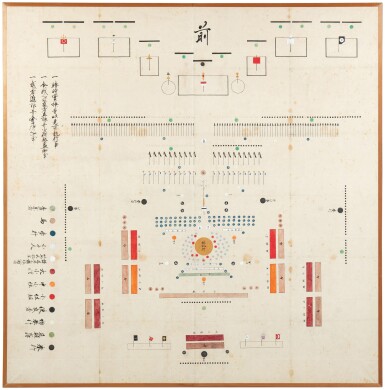Un autre regard : Collection Edric van Vredenburgh, Part I
Un autre regard : Collection Edric van Vredenburgh, Part I

Two rare two-fold screens, Japan, late Edo period, 19th century | Deux rares paravents à deux feuilles, Japon, fin de l'époque Edo, XIXe siècle
Auction Closed
April 13, 03:37 PM GMT
Estimate
20,000 - 25,000 EUR
Lot Details
Description
Two rare two-fold screens
Japan, late Edo period, 19th century
one depicting the military headquarters map; the other the Front of military formation
183.5 x 182 cm, 72¼ by 71⅝ in.; 184.7 x 182 cm, 72¾ by 71⅝ in.
(2)
_____________________________________________
Deux rares paravents à deux feuilles
Japon, fin de l'époque Edo, XIXe siècle
une représentant la carte du quartier général militaire; l'autre le front d'un unité militaire
183.5 x 182 cm, 72¼ by 71⅝ in.; 184.7 x 182 cm, 72¾ by 71⅝ in.
(2)
This pair of two-panel folding screens provides insight into the types of military camp settings and formations used during the sixteenth and early seventeenth century. The first screen, titled Honjin zu (A Picture of a Military Stronghold), shows the delineation of a daimyo led sonae [unit], otherwise referred to as the honjin. The second screen illustrates the deployment of battalions in a manner typical of the Sengoku period: ashigaru [light infantry], armed with the tanegashima matchlock, are placed on the front line to inhibit a direct calvary charge. Pikes are deployed to their rear, forming a buffer between the ashigaru and the general's direct command – here indicated by the yellow circle to the lower centre of the formation, and flanked by calvary to either side. Throughout the map are indicators of sashimono [personal flags], umajirushi [camp standards] and hata [banners] that were used to distinguish units on the battlefield.
Cette paire de paravents à deux panneaux donne un aperçu des types de camps et de formations militaires qui existaient au XVIe et au début du XVIIe siècle au Japon. Le premier paravent, intitulé Honjin zu (Image d'une forteresse militaire), laisse apparaitre le dessin d'une sonae [unité] dirigée par un daimyo, aussi appelée honjin. Le deuxième écran illustre le déploiement des bataillons d'une manière caractéristique de la période Sengoku : les ashigaru [infanterie légère], armés du tanegashima (arme à feu pourvue d’une platine à mèche), sont placés en première ligne pour empêcher une charge directe de la cavalerie. Des piques sont déployées à l'arrière, formant un tampon entre les ashigarus et le commandement direct du général - ici indiqué par le cercle jaune au centre inférieur de la formation, et flanqué de la cavalerie de chaque côté. On retrouve sur la carte des indicateurs de sashimono [drapeaux personnels], umajirushi [étendards de camp] et hata [bannières] qui étaient utilisés pour distinguer les unités sur le champ de bataille.
